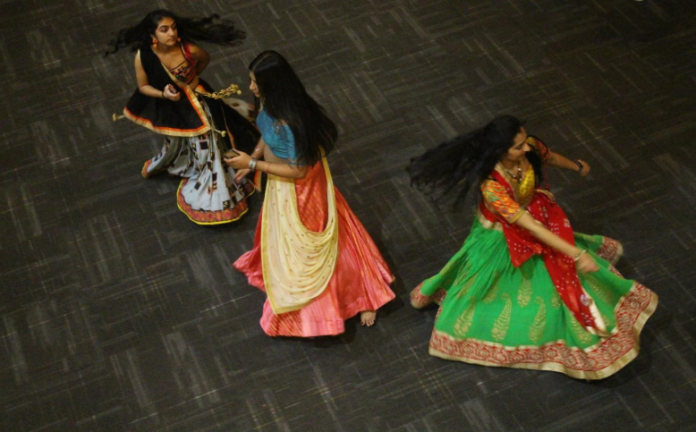
Rowan Rangeela, a club dedicated to the traditions and cultures within the South Asian community, and Rowan After Hours brought Navratri Night to the Student Center Thursday with free Indian food, henna tattoos, and diya painting. Navratri (Sanskrit for nine nights) is a major festival in honor of the divine feminine.
According to Britannica, “For many people, [Navratri] is a time of religious reflection and fasting; for others, it is a time for dancing and feasting.” The first third of the festival usually focuses on the Hindu goddess Durga, who is known as the protector of the universe. The second third focuses on Lakshmi, the goddess of wealth and good fortune, while the final third focuses on Sarasvati the goddess of learning and the arts.
RAH dished out authentic Indian food, including methi paneer (cottage cheese cubes with yogurt and Indian spices), biryani (mixed rice with sweet vegetables), naan (Indian flatbread), and gulab jamun (an Indian milk-based dessert surrounded by sweet syrup).
While students ate and played Carrom and other Indian board games, Rowan Rangeela performed two styles of dances, Dandiya and Garba.
“It’s Indian dance but with American flavors to it, so it’s like a fusion of our upbringing,” said Srishti Dhar, a junior biochemistry major and vice president of Rowan Rangeela. She’s been dancing since she was a child.
“When RAH does around-the-globe things, those are my favorite because it’s really special to see into a culture,” said Sanjana Kondapalli, a sophomore civil engineering major and one of the dancers.
Her favorite part of the night was dancing and being able to dress up in traditional Indian clothes. After she finished dancing, Kondapalli wore an emerald green and light gold salwar kameez (also spelled shalwar), which is a long tunic and tapered pants.
Nina Nandy, a senior finance major, explained some of the other traditional clothing. Nandy wore a red lehenga, which has a skirt and a top. Others are dressed in a sari (or saree), which consists of a long length of cloth that can be wrapped around in multiple ways, depending on the region and style.
“I couldn’t breathe by the end of the songs,” said Nandy regarding her dancing experience.
According to an article from the Lincoln Center, Garba (which comes from the Sanskrit for “womb”) is a dance performed by women in a circle around a clay lantern or “womb lamp.” They dance around this symbol to honor the fact that all humans have divine energy.
The dance is done barefoot because the foot is thought of as a conduit through which the energy of the earth travels through humans and it’s a way to connect with Devi (Sanskrit for “goddess”).
Rowan Rangeela also performed Dandiya, where dancers hold colorful sticks called Dandiya sticks and strike their partner’s sticks while moving in circular patterns.
Lance Guzman, RAH co-sponsorship coordinator, and junior biomedical engineering major helped put together the event with Rowan Rangeela.
“I definitely would like to see them come back again next fall,” Guzman said.
Rowan Rangeela also performed at the Women in the Arts Festival last Friday at the Women’s Center in Hawthorn Hall. Future events can be found on their Instagram account, @rowanrangeela.
For comments/questions about this story DM us on Instagram @thewhitatrowan or email the.whit.arts@gmail.com.




